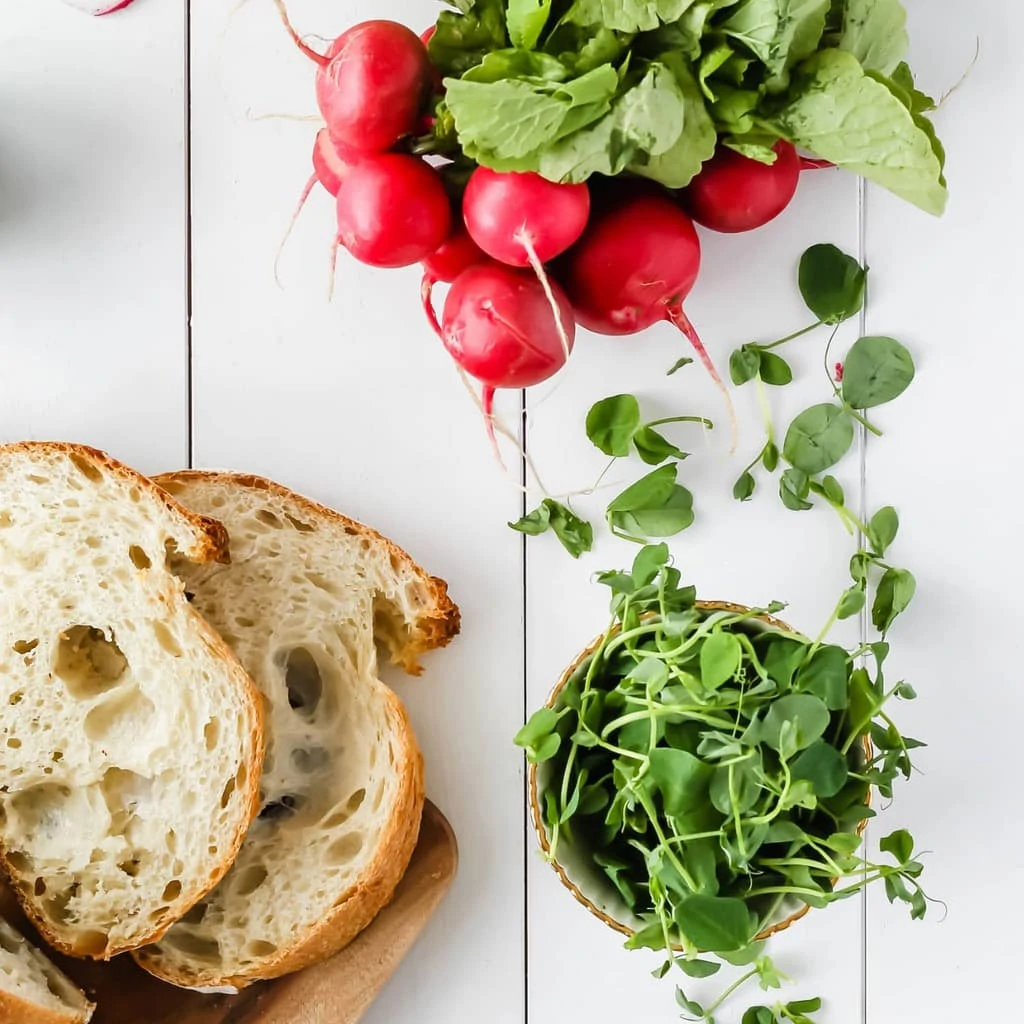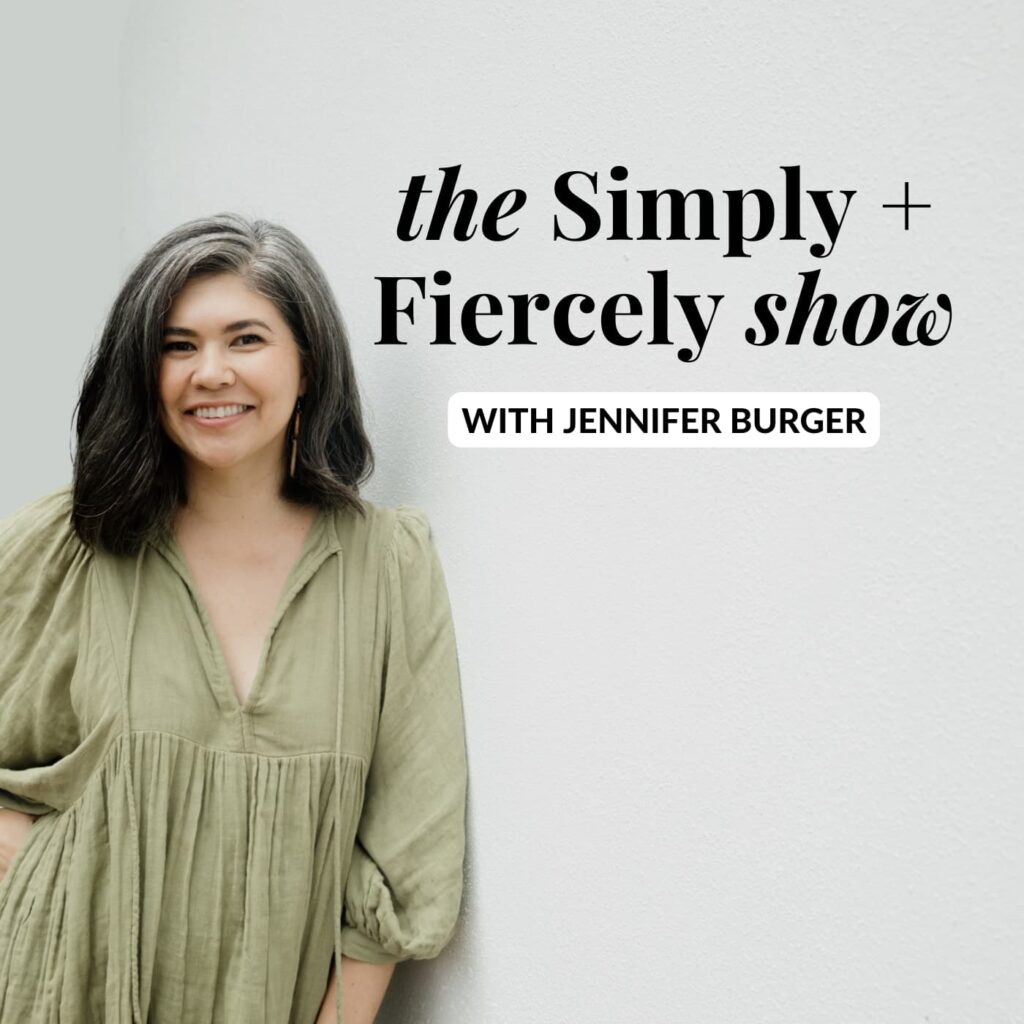Do you hate meal planning? Is dinnertime always stressful in your house? Do you waste a lot of money on food that never gets eaten? If so, then I want to share a solution that has made a HUGE difference in my life: simple eating.
Simple eating is inspired by my minimalist lifestyle and—as someone who really dislikes cooking—it has been a lifesaver. I’m rarely stressed about meals, I save a TON of money, I’ve reclaimed my evenings, and as an added bonus, I’ve even started eating healthier.
Does this sound too good to be true? I promise it’s not! Keep reading to learn more about my minimalist eating philosophy and how you can apply it in your own kitchen.

Note: I originally published this post in 2015, but I’ve since updated it (2023) to reflect my lifestyle changes and to provide more practical examples.
Why I Don’t Meal Plan
Before I begin, I feel like I should tell you a bit more about what didn’t work for me: meal planning.
Now, I know that there are a ton of people who love meal planning, and it works really well for them. If you’re one of those people, then that’s fantastic! I’m glad you found a system that works for you and your family.
But meal planning did NOT work for me, and I’m guessing I’m probably not alone. Here are a few reasons why:
First of all, I like to eat what I’m in the mood for. This was my biggest problem—if I was in the mood for Mexican and I had planned to have pasta, I’d be really annoyed. I’m not good at making myself do things I don’t really want to do, so I’d usually abandon my meal plan and go out for tacos instead!
Also, I needed more flexibility. Not only did I want to be flexible about what type of food I was going to eat, but I also needed to be more flexible about when I ate it.
For example, at my old job, I often worked late, and by the time I got home, I’d be too tired to cook whatever was on the plan that night. Instead, I’d find something else to eat, which would throw everything off, and by the end of the week, there would be wasted food.
Finally, meal planning didn’t work for me because I didn’t enjoy it. I know that if I tried harder, I probably could have overcome these obstacles. I could have been more organised, did more food prep, etc.— but ultimately, I didn’t have the motivation.
Meal planning just didn’t fit with the lifestyle that I wanted for myself. Again, this isn’t to say that meal planning is bad, but it wasn’t for me.
I knew there had to be a different way, so I started to rethink my approach to meals.
Introducing Minimalist Eating
A minimalist approach to food
Around this same time, I was learning a lot about minimalism, and I started taking steps to simplify my closet. Part of the process was creating a capsule wardrobe.
Now, if you’re not familiar with the term, the idea is simple: you have a small closet full of pieces that you love that can easily be mixed and matched. It takes the stress out of getting dressed because you don’t have to plan or worry too much about what goes with what.
Instead, you can feel confident that most anything you pull out will go together—plus you know that you’ll love whatever you pick because you only keep items that you love!
With this in mind, I started to wonder if I could take a similar approach in my kitchen.
Instead of planning meals, could I create a “capsule kitchen” full of foods I love and use “food uniforms” to make mealtimes easier?
The answer is yes, and here’s how minimalist eating works.
The capsule kitchen
The idea behind a capsule kitchen is simple: stock your home full of “go-to” foods that you know you love eating instead of shopping for meals.
This is what it looks like for me:
- a pantry stocked with my favourite basics (rice, ramen noodles, beans and tortillas)
- seasonal fruit and vegetables
- cheese, eggs, and a small portion of meat
- a selection of my favourite condiments and spices*
*For condiments and spices, I have a few “flavour families” I always turn to. (Again, with the fashion analogy, these are like your favourite accent colours!) These include Mexican (cumin, chilli, lime), Asian (soy sauce, ginger, sriracha) or good old garlic and herbs.
I rarely shop with any particular meals in mind, and I only use a list to remind me if I’ve run out of any pantry essentials. I usually buy one big portion of meat for the week (like a lamb roast), which I’ll cook early in the week, and then we have a little every day. For fruit, veg, cheese, etc. I generally buy less than I think I need, and I always make sure I love everything I buy.
That last bit is so important and the key to making this work!
If you enjoy eating everything you buy (and you don’t overshop), you won’t end up with food wastage. Since we’re not worrying about recipes or having “planned meals”, you can make whatever you buy work with almost anything.
Your food uniform
Next, yet another fashion analogy!
There are a lot of people within the minimalist community who embrace the concept of a personal uniform. A personal uniform is basically just a signature look—a “go-to” style that you wear all the time.
For example, when the weather’s cool, my personal uniform is skinny jeans, oversized tops and ankle boots. It’s a look I love, and I know that on any given day, I will feel good wearing it.
Of course, I can mix things up with different accessories or by adding layers, but ultimately, the foundations of my outfit are usually the same.
A food uniform works exactly the same way.
There are a few basic “food structures” I know I love eating—stir-fries, salads, bowls (see link below), tacos—so I make these the foundation of almost every meal. These are all super easy and quick to make, even for someone with my limited cooking skills!
All I have to do is pick a uniform and then add to it from my capsule pantry—and I’ve got yummy meals with almost no effort or planning!
If you’re really new to cooking (honestly, I think I was 25 before I learned to cook a stir fry, so don’t feel bad!) or if you want some resources to help you establish your food uniform, here are some articles that might help you:
These articles will help you with the basics but remember the whole point of simple eating is you don’t have to follow a recipe. Just keep it simple and eat what you like!
Ready for some real-world examples? Keep reading!
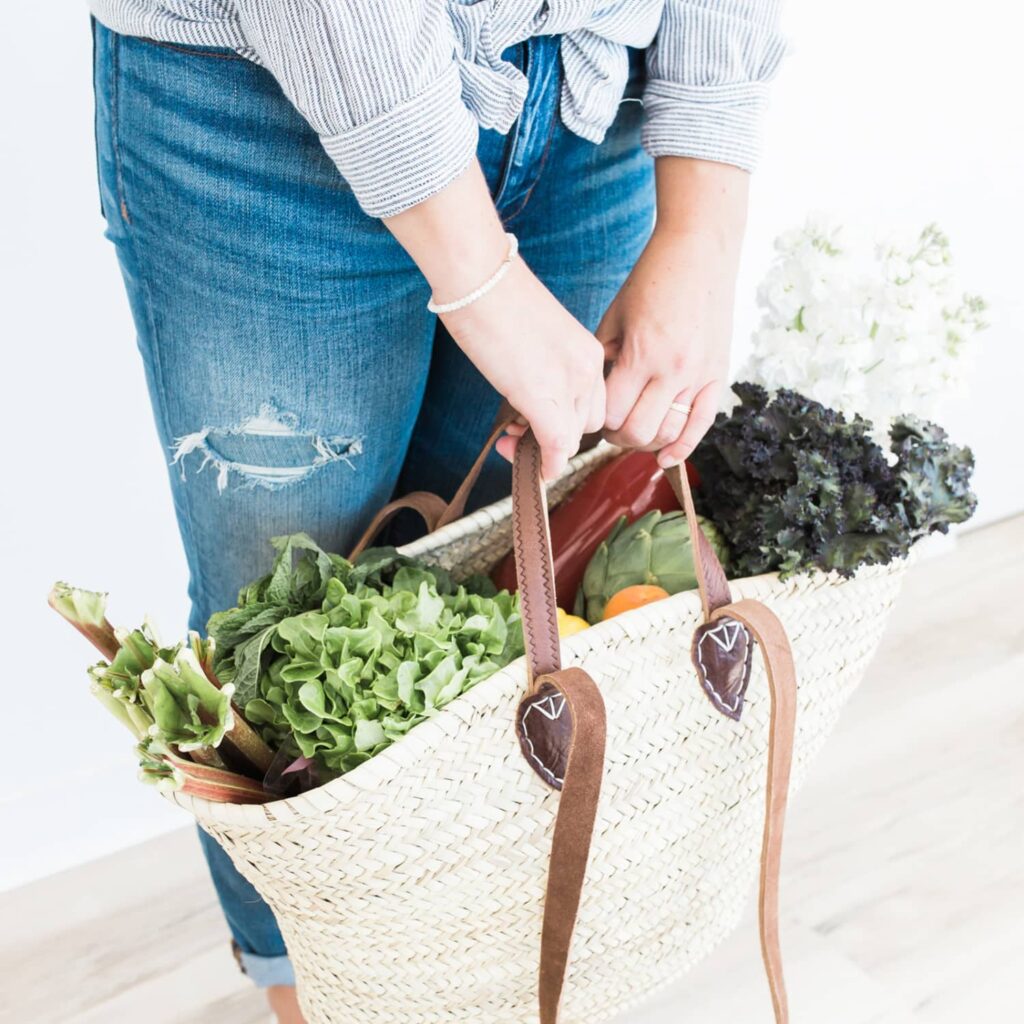
Shopping for food
Let’s start with food shopping because I know this is stressful for a lot of people.
As I mentioned, there are some things I always keep in my house, including rice, beans, noodles, tortillas, certain spices and condiments. I usually only shop for these things about once a month, and because I’ve been buying the same things for so long, I rarely need a list. I often do this shop online to make things even easier!
Then each week, I usually buy the following from the supermarket:
- one portion of meat (like a lamb roast or a whole chicken—something I can cook once at the start of the week) – Overall, this means we don’t eat a lot of meat. We definitely aren’t vegetarians, and we eat meat at most meals, but it’s not the hero of our meals. A 1kg roast might seem like a lot, but it’s not when you spread it out over a week. This saves a ton of money and actually makes cooking easier too.
- cheese – I usually buy a block of cheddar as part of my big monthly shop but will get a small portion of something special each week to “accessorise” my meals!
- yoghurt and eggs
I’m also fortunate to live down the road from a great farmer’s market, so this is where I buy most of my fruit and vegetables. I rarely have a list, but I usually have a rough budget in mind. I buy whatever is in season that I know my family will love.
Right now, it’s usually a mix of potatoes, broccoli, cauliflower, carrots, cabbage, onions, peppers, apples and bananas.
Again, I have no plan for what I’m going to use this food for when I buy it— this is where my food uniform comes into play!
Simple Eating In Action
On any given day, I generally start by deciding which of my “food uniforms” I feel like eating.
Let’s say I’m in the mood for tacos. I go to my fridge, grab whatever meat or vegetables I feel like, toss them in a pan with a bit of cumin and chilli, and serve with lime and tortillas!
What I’ve found is that if I have the basics (some spices and tortillas) is that I can add almost anything. I’ve had cauliflower tacos, egg and bean tacos, steak tacos—I’m pretty sure I’ve put almost everything in a taco! It’s a great way to clean out the fridge.
The same applies to stir-fries, salads or bowls. I choose a base, add meat and veggies, and then “accessorise” with spices, cheese, sauces, etc. Just like a capsule wardrobe, you can mix and match almost anything.
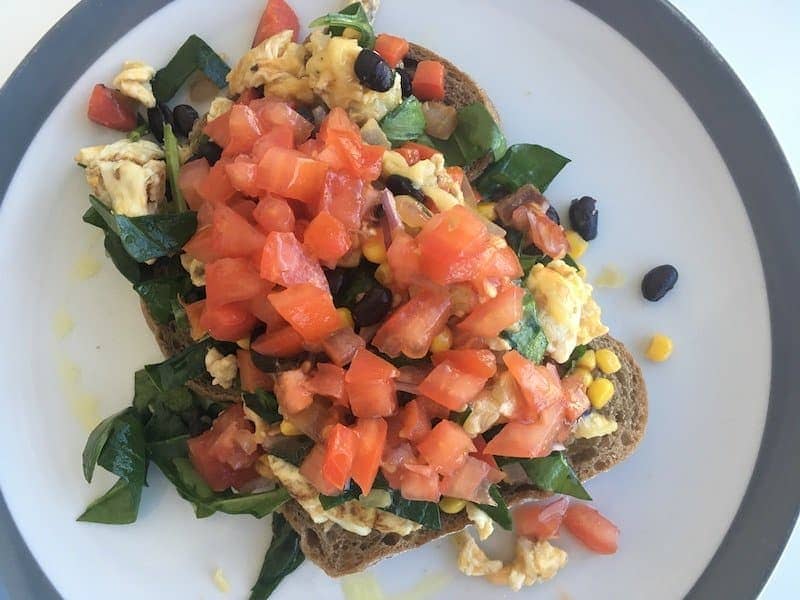
Here are more examples:
- stir fry with noodles, chicken, broccoli, cabbage, and onions—add sweet soy sauce and sriracha sauce
- bowl with rice, eggs, beans, peppers, and cabbage—add cheese and avocado
- salad with spinach, chicken, potatoes, carrots, and beans—add cheese and dressing
- the possibilities are virtually endless—just mix and match!
It very rarely takes me longer than 30 minutes to make dinner and usually a lot less. It’s usually just a bit of chopping and then tossing it into a pan or the oven.
If this sounds simple, it’s because it IS simple!
In fact, I’m sure there is probably someone reading this thinking—what’s the big deal? I do this all the time.
But for me, knowing that I didn’t have to make real “meals” (meaning something you’d find in a cookbook) was a huge mindset shift. I gave myself permission to make things easy and realised that I didn’t need to cook certain types of meals to be a good wife or a good mum.
Want to learn more about minimalism and simplifying your life? Here are a few popular posts you might enjoy:
Simple Eating article continues below.
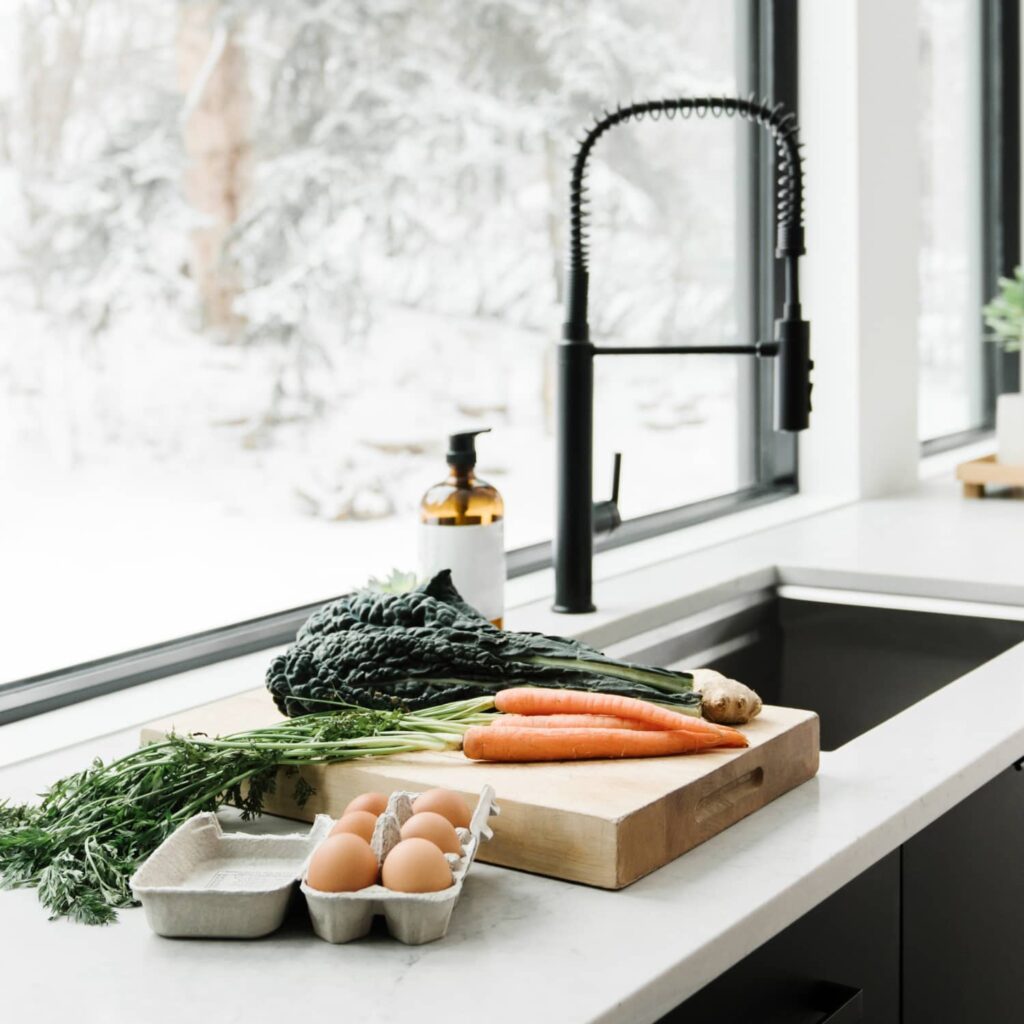
A Few More Simple Eating tips
I personally don’t do any food prep ahead of time, but I will often do it as I go. For example, if I’m going to use some chicken on a Monday, I’ll cook it all at once. It makes things easier throughout the week. Sames goes with chopping vegetables; if I need a bit of broccoli, I’ll go ahead and chop it all.
I found this is a really good balance for me. I’m a little bit prepared without having to be too organised!
If you’re worried about getting bored, mix up the flavours—not the structure. I honestly eat tacos 2-3 times a week, but I don’t get bored because I mix things up with sauces, spices, vegetables etc.
Remember the capsule wardrobe analogy; a white t-shirt and jeans can be mixed to make 100 different outfits if you get creative! Changes your shoes, and your handbag, add a scarf, put on a sweater—the possibilities are endless. The same applies to minimalist eating!
Have a “use it up” shelf in your fridge. Put leftovers or anything that needs to be eaten soon on this shelf so you don’t forget about it.
One tip to help you clear this shelf is by having what I call a “platter meal”. I grab my biggest cutting board and clean out the fridge: some leftover chicken, carrot sticks, hardboiled eggs, a bit of cheese, maybe some nuts and bread on the side.
As always, it doesn’t matter what I grab because it’s all food that I know my family loves to eat.
Don’t be afraid of an empty fridge. The goal of simple eating is to eat everything you buy! An empty fridge at the end of the week is a good sign because it means you are not wasting food!
The Simply + Fiercely Show is a podcast for women who want to clear their clutter and create space for freedom and joy. If your life keeps getting bigger—but not better—then it’s time to declutter from the inside out. LISTEN NOW
How Eating Simply Has Changed My Life
First and foremost, simple eating saves me a lot of money.
Before simplifying my eating habits, I would always buy too much food. If you’re not organised (like me), cooking set meals means buying lots of different ingredients, and so often, I use a tiny bit for a recipe, and then the rest would go to waste.
Or if I didn’t plan well (which was always), I’d end up with a ton of food in my fridge that I didn’t know what to do with. I wasted SO MUCH food!
When I began to practise minimalist eating, I started buying a lot less—but it was never a problem because we actually ate it all! We also eat out a lot less often, and that made a huge impact on our budget (and helped us become debt-free!).
Another benefit of simple eating is I’m actually eating healthier too. Although my intention was not to go on a diet, simplifying my meals helped me lose the last 5kgs I’d been hanging onto for years. I think this is because vegetables are the core of my diet now and again, I’m not eating out as often as I used to.
Finally, the number one benefit of simple eating is how little time and effort I spend cooking and food shopping. I’m usually in and out of the supermarket in less than 20 minutes, I don’t plan meals, and I no longer spend hours in the kitchen. This is time saved that I now spend with my loved ones, writing or taking care of myself.
What do you think? Would simple eating work for you? Let me know in the comments! x
